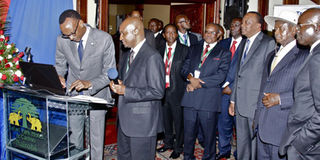Online clearance system to save Kenya billions in cargo handling

Rwanda's President Paul Kagame officially launches the Kenya National Electronic Single Window System (KENYA TRADENET) at Safari Park Hotel on May 2, 2014. With him are Presidents Uhuru Kenyatta,Yoweri Museveni of Uganda and Deputy President William Ruto. PHOTO/PSCU
What you need to know:
- Launch of Tradenet program will go a long way in cementing the country’s standing as the gateway to the East Africa market.
- Once fully rolled out, it is estimated that the Single Window will save Kenya between Sh13.03 billion and Sh21.72 billion per year within the first three years.
Kenya has launched a paperless cargo clearance system. The platform is expected to save the economy billions of shillings by cutting the cost and time it takes to move goods across ports of entry.
The Electronic Single Window System, also known as the Kenya Tradenet System, has been piloted by the government since October last year. Its official roll out will cement Kenya’s role as the gateway to East Africa by making it easier and cheaper for traders to transport goods within the region.
Presidents Uhuru Kenyatta, Paul Kagame of Rwanda and their Ugandan counterpart Yoweri Museveni officiated at the launch ceremony at Safari Park Hotel in Nairobi on Friday.
Tanzania and Burundi sent government representatives.
DISJOINTED SYSTEMS
The single window will replace an environment whereby almost every government agency involved in cargo clearance manages its own systems.
And with the volume of cargo coming into the region through Kenya rising every year, the disjointed systems used by the government to clear goods have often been blamed for congestion and delays at the Port of Mombasa.
According to the Economic Survey 2014, the cargo handled at Mombasa port increased by 1.8 per cent to 22.31 million tonnes last year.
Currently, it takes an average of seven days to complete clearance of goods at the harbour. Kenya hopes to drastically cut this dwell time with the new platform.
“With the electronic Single Window System in place, we intend to progressively reduce the cargo dwell time at the Port of Mombasa to a maximum of three days and at the JKIA to one day so as to significantly ease the cost of doing business in the region,” noted Mr Kenyatta.
SINGLE PLATFORM
The system will basically give traders a single platform within which to lodge documents associated with cargo clearance. From this platform, information can be shared with various government agencies, including the Kenya Revenue Authority, the Kenya Plant Health Inspectorate Services, the Kenya Bureau of Standards and the Kenya Ports Authority.
Once fully rolled out, it is estimated that the Single Window will save Kenya between Sh13.03 billion ($150 million) and Sh21.72 billion ($250 million) per year within the first three years. The savings are expected to rise to between Sh26.1 billion ($300) and Sh39.1 billion ($450 million) after the initial three years.
Further, Mr Kenyatta said that the system will be integrated with the government’s planned electronic payment system thereby eliminating the corruption networks associated with the payment of fees at the ports of entry.
The software integrates over 24 government agencies, various payment modes including mobile money and 24 commercial banks at the moment.
EASING CONGESTION
Ultimately, East African countries hope to conduct business from a single window system.
In August 2012, Rwanda became the first EAC country to launch a single window. Tanzania and Uganda are working on similar initiatives while the bloc’s secretariat is spearheading a project to integrate all the platforms.
Giving an integration update at the forum, President Kenyatta said that the EAC programme on infrastructure is on the right track. Progress had been made to ease congestion at the ports and in barriers along the main transport corridors that hindered faster movement of goods.
“Containers from Mombasa once took 18 days to reach Kampala; that has now been reduced to four days. The journey from Mombasa to Kigali now takes six days in contrast to 22 days not long ago,” the President said.
The launch of the East African Tourist Visa and use of identity documents to travel within the region was now operational, turning the participating countries into a single tourist destination.
ENERGY PRODUCTION
On energy, the President said deficiencies in production are being addressed through investment in generation and transmission. Key projects include geothermal production, construction of oil pipelines, power interconnection and the set up of an oil refinery, Mr Kenyatta added.
“The Memorandum on Geothermal Energy was signed in February, while the electricity inter-connections between our countries will be completed in April next year,” he said.
Terrorism
On security, the President said terrorism poses a major threat in the region. Infrastructure works in the bloc can only be addressed in an atmosphere of peace, he noted.
“In the near term, we will need to expand, upgrade and rehabilitate the transport network throughout our entire region to open wider economic opportunities for our peoples,” said Mr Kenyatta.





